Are you worried about your home safety? Securing outswing door is essential to protect your house from potential intruders. Here are some useful tips on how to secure outswing door.
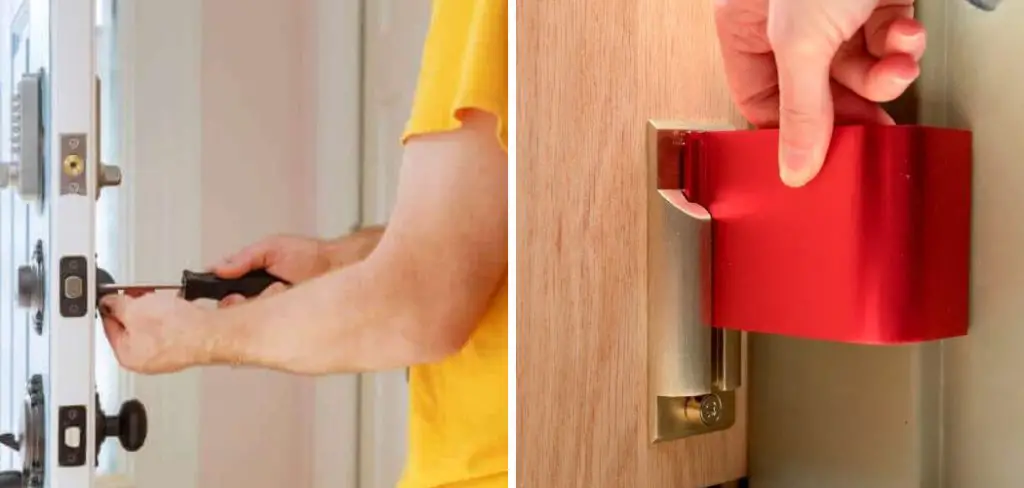
Securing outswing doors is particularly important when it comes to ensuring the safety and security of your home. Outswing doors, which open outward instead of inward, are commonly used for their space-saving functionality and resistance to forceful entry. However, they can present unique security challenges. To effectively secure these doors, it is crucial to implement strategies that address their specific vulnerabilities.
In this section, we will explore various methods and tools to enhance the security of outswing doors, provide peace of mind, and safeguard your property. Let’s start by understanding their potential weaknesses.
What are the Potential Weaknesses of Outswing Doors?
Outswing doors can be vulnerable to forced entry if proper security measures are not in place. Here are some common weaknesses that need to be addressed:
- Hinge Attacks: The hinges of an outswing door are exposed on the outside, making them vulnerable to attacks. An intruder could easily remove the hinge pins and remove the door from its frame.
- Weak Locks: Many outswing doors come with standard locks that can be easily picked or forced open. This makes it easier for burglars to break in without much effort.
- Lack of Reinforcement: Unlike inswing doors with a built-in lip on the latch side that prevents prying, outswing doors lack this feature. As a result, they can be more prone to being pried open.
What Will You Need?
Before we dive into the different techniques for securing outswing doors, let’s take a look at some essential tools and materials you will need:
- Quality Locks: A good lock is the first line of defense for any door. Choose from heavy-duty deadbolts, keyless entry systems, or multipoint locking systems that engage multiple points along the door frame.
- Security Film or Bars: These are transparent films or bars that can be applied to the glass panels on your door to prevent easy breakage.
- Motion Sensor Lights: To deter potential intruders, install a light above or near your outswing door. These lights will automatically turn on when they detect movement, making it difficult for anyone to approach your door unnoticed.
- Security Cameras: Consider installing security cameras near your outswing door. This acts as a deterrent and provides visual evidence in case of any break-ins.
- Door Reinforcement Kit: A reinforcement kit adds an extra layer of security by fortifying the hinges and strike plate, which are often weak points in outswing doors.
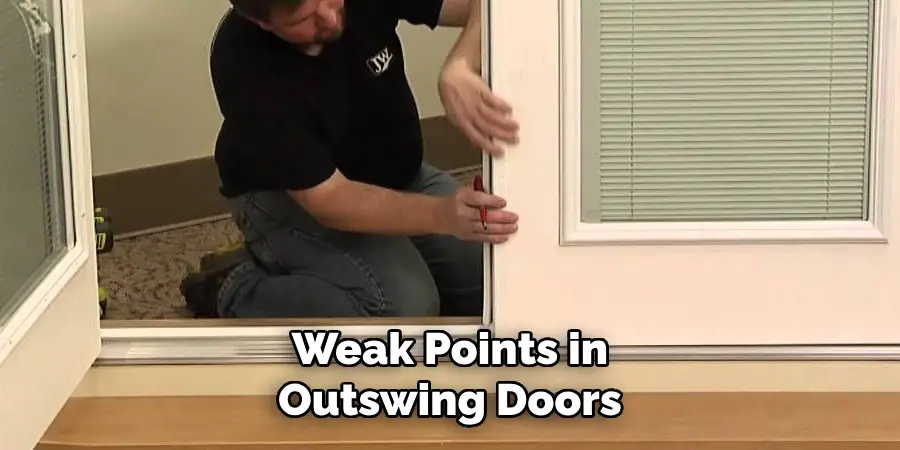
Now that you have all the necessary tools and materials let’s explore different techniques for securing outswing doors.
10 Easy Steps on How to Secure Outswing Door
Step 1: Assess the Vulnerabilities
Before implementing any security measures, it is essential to identify the potential weak points in your outswing door. Inspect the hinges, locks, and glass panels for any signs of wear and tear or damage. This will help you determine which areas require additional reinforcement.
Step 2: Install Quality Locks
As mentioned earlier, a high-quality lock is crucial for securing your outswing door. Consider installing a deadbolt with at least a one-inch throw bolt that extends into the door frame when locked. You can also opt for a keyless entry system with added convenience and security.
Step 3: Reinforce the Hinges
The hinges of an outswing door are crucial, as they are accessible from the outside and could potentially be tampered with. Start by installing security hinges, which feature non-removable pins to reinforce the hinges. This prevents intruders from easily removing the hinges to gain access.
Additionally, consider using hinge bolts or security studs. These small metal bolts extend from the door into the frame, providing an extra layer of security even if the hinge pins are removed. Align them properly with the door frame to ensure they fit snugly when the door is closed.
You can also replace existing screws in the hinges with longer screws, ideally, 3 inches or longer, that reach deep into the door frame and wall studs. The longer screws make it significantly more difficult to kick in or force the door open.
Reinforcing the hinges not only strengthens the door but also delays and deters any attempts at forced entry, making it a critical step in securing your outswing door.
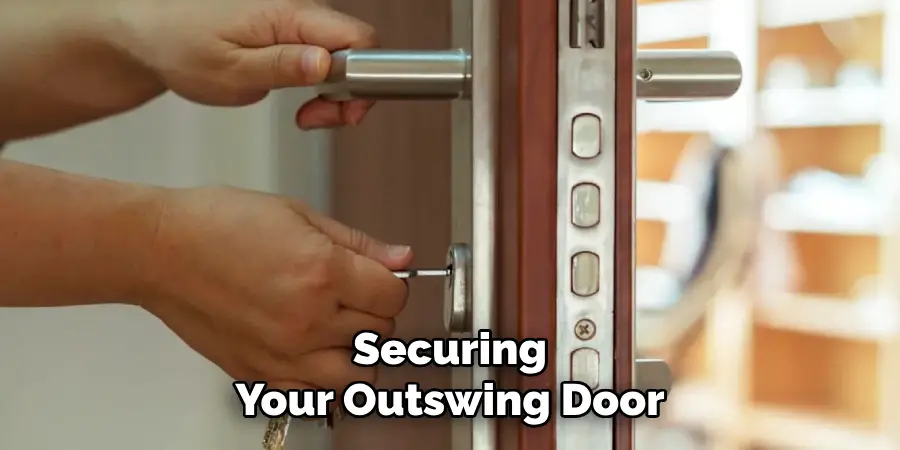
Step 4: Apply Security Film or Install Security Bars
Glass panels on outswing doors are attractive features but also make the door more vulnerable. Applying a security film to the glass can help prevent easy breakage. These films are transparent and bond to the glass, increasing its strength and making it shatter-resistant. They can be easily applied and do not affect the appearance of your door.
Consider installing security bars over the glass panels for even more robust protection. These bars come in various designs and can be matched to the aesthetic of your home. They add a physical barrier that prevents intruders from breaking the glass and reaching inside to unlock the door.
By securing the glass components of your outswing door, you can reduce the risk of break-ins and ensure a higher level of home safety.
Step 5: Add a Strike Plate Reinforcement
The strike plate is the metal piece attached to the door frame where the lock bolt slides into place. It is a critical component that can be weak if not properly reinforced. Standard strike plates are often held by short screws that only penetrate the door jamb, making them easy to break through.
To reinforce the strike plate, upgrade to a heavy-duty version, which includes a larger plate and longer screws. Ideally, these screws should be at least 3 inches, penetrating deep into the studs of the house framing. This provides a much stronger anchoring point, making it substantially more difficult for an intruder to open the door.
Installing a reinforced strike plate is a relatively simple and inexpensive improvement that significantly enhances the security of your outswing door.
Step 6: Install a Door Reinforcement Kit
A door reinforcement kit is a comprehensive solution that addresses several weak points in your door structure. These kits typically include plates reinforcing the door jamb, hinges, and lock area. Start by following the manufacturer’s instructions to install the reinforcement plates around the door’s lock and strike area. Ensure the plates are securely fastened with long screws that reach the stud, offering maximum reinforcement and resisting forceful entry attempts.
By fortifying the key areas of your outswing door with a reinforcement kit, you add a significant layer of defense against break-ins, making it a crucial step in securing your home.
Step 7: Setup Motion Sensor Lights
Motion sensor lights are an effective deterrent for potential intruders. Position these lights strategically around your outswing door—preferably above or adjacent to the door. Install the lights according to the manufacturer’s instructions, ensuring they cover all possible entry points. When the sensors detect movement, the lights will turn on, illuminating the area and alerting you and your neighbors to any suspicious activity.
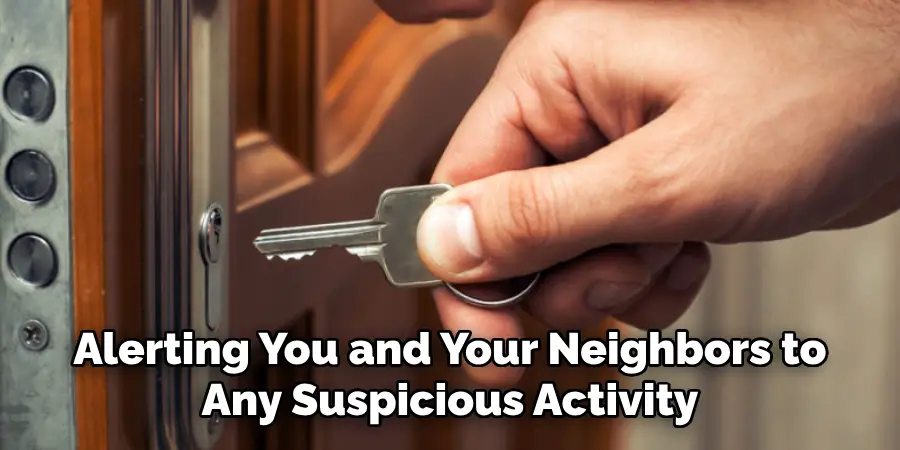
Adding motion sensor lights enhances the security of your outswing door and provides peace of mind, knowing that any movement around your property will be noticed.
Step 8: Install Security Cameras
Security cameras serve a dual purpose: they deter potential intruders and provide evidence in case of a break-in. Choose high-quality cameras with night vision and motion detection features for optimal security. Position the cameras to cover all angles of your outswing door and connect them to a reliable monitoring system. Ensure that the camera feeds are accessible remotely via your smartphone or computer.
By installing security cameras, you create a vigilant presence around your outswing door, making it less likely for intruders to attempt a break-in and more likely for law enforcement to apprehend them if they do.
Step 9: Use a Door Brace
A door brace is an additional security measure that provides a robust physical barrier against forced entry. These devices can be easily installed at the base of your outswing door. When extended, the brace applies pressure against the door and the floor, making it virtually impossible to kick the door open. Select a door brace that is adjustable and compatible with your door type.
Implementing a door brace creates another formidable obstacle for potential intruders, significantly enhancing the security of your outswing door.
Step 10: Regular Maintenance and Inspections
Ongoing maintenance and regular inspections are essential for maintaining the security of your outswing door. Routinely check the condition of the locks, hinges, strike plates, and reinforcement elements. Look for signs of wear and tear and promptly address any issues. Ensure that all the security measures you’ve implemented remain functional and in good condition over time.
Regular maintenance and inspections ensure that your outswing door remains a reliable barrier against intruders, safeguarding your property and loved ones effectively.
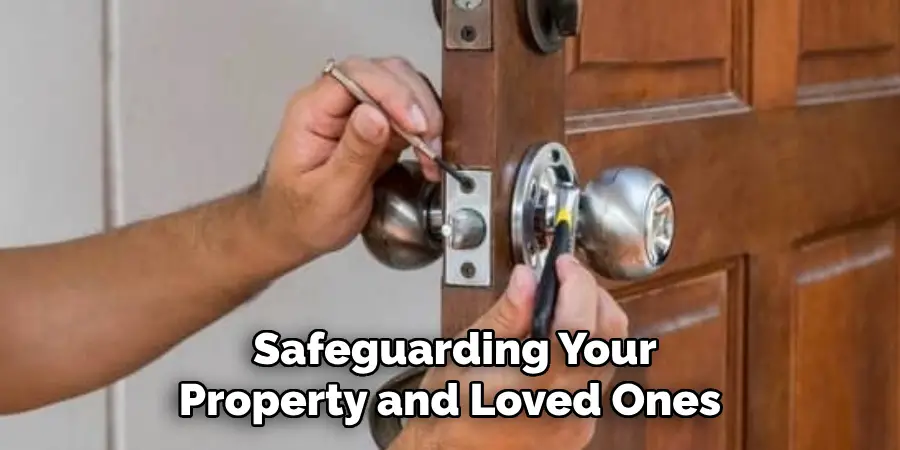
Conclusion
How to secure outswing door requires a combination of strategic enhancements and regular upkeep to ensure optimal safety.
By following the detailed steps outlined, homeowners can greatly enhance the security of their outswing doors. Starting with high-quality locks and strike plates and reinforcing these with additional hardware like door braces and security bars provides robust physical barriers against forced entry.
Moreover, integrating technology like motion sensor lights and security cameras adds a vigilant layer of security that deters intruders and aids in monitoring and evidence collection. Lastly, consistent maintenance and inspections ensure that all security measures remain effective over time.
Together, these measures form a comprehensive approach to protecting your home, providing peace of mind, and safeguarding your property against potential threats.
